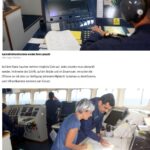“Zoom in with infrared on target 22. Its movement seems suspicious and they didn’t reply on channel 12”.
The voice of the Commander is loud and clear. He and his 52 member crew are checking hundreds of ships sailing in the East Aegean every day. It has now been two weeks since the Turkish coup attempt that resulted into his vessel getting engaged in one of the biggest military operations in the area.
The reason: to patrol for Turkish putschists trying to escape from Turkey to Greece, much like the eight officers did with their helicopter, on Saturday 16th in Alexandroupolis.
Bild managed to get permission to be on board the Greek Navy vessel “Daniolos” and witnessed the patrolling operation, while thousands of Turkish military officers were being kicked out of the Army from the Turkish President Tayyip Erdogan.
On the night of the coup, Greece sent 13 Navy vessels to the East Aegean. “My phone rang. The orders were: ‘Warm up the engines, you are leaving, head East”. We only had a few minutes to pick up some clothes and sail away. No one knew what would follow” said Lieutenant Commander Panagiotis Paraskevas (41) to Bild.
Things got worse when the eight Turkish officers landed in Northern Greece. The burden of their extradition to Turkey as Tayyip Erdogan requested and the unprecedented diplomatic tensions were more than enough for the Greek government, which aimed to discourage other putschists from entering the county’s territory. This is why patrolling is continuous and helicopters have joined the operation.
Turkey sent 18 vessels in the area, helicopters and even fighter jets, following the rumors of Saturday the 20th, according to which, more putschists were heading to Greece by inflatables trying to escape towards the island of Symi.
The patrol that Bild witnessed, ran in the exact same area, that is, in the middle of the maritime boundaries, 2,4 miles away from each county’s coast. This is the distance separating Greece and Turkey, or Europe and Turkey…
Multiple possible targets are being tracked by the radars. Each one needs to be checked. On board the vessel, on the commander’s bridge and the operations room, officers are checking them using every possible high tech system at their disposal, including long distance infrared cameras. On the deck, other officers are checking the area using binoculars while having their hands on their machine guns…
And what happens if a target is suspicious? “We are making contact using the radio frequencies. If they do not respond, we are heading to the target, we contact the Coastguard on the spot and we remain in the area” Lieutenant Commander Paraskevas says.
The fact that the Greek court decided to grant more time to the 8 military officers who fled to Greece by helicopter (on Wednesday) in order to prepare their applications for political asylum, made patrolling harder, as more putschists might imitate their colleagues’ actions instead of facing the situation in their country.
The asylum interview dates of the eight have been rescheduled for 19, 23, 24 and 25 of August, although Ankara insists that the officer’s applications for political asylum in Greece should be rejected and presses for their extradition to Turkey to stand trial as “traitors”.
This delicate matter burdens Lieutenant Commander Paraskevas and his crew too. Taking part in such an operation is not exactly what military personnel wishes for. They are not allowed to discuss politics or make any comments regarding foreign policies. But what they are thinking is more than obvious when someone looks at their faces: When your neighbor’s house is on fire, your house is in danger too.
This red alert condition is going on every day in the East Aegean Sea. And to be more precise, this takes place exactly on the Eastern borders of Europe, with two NATO countries involved…














